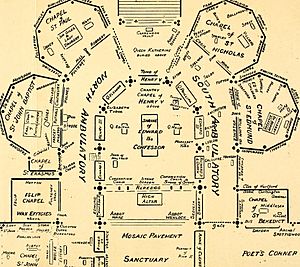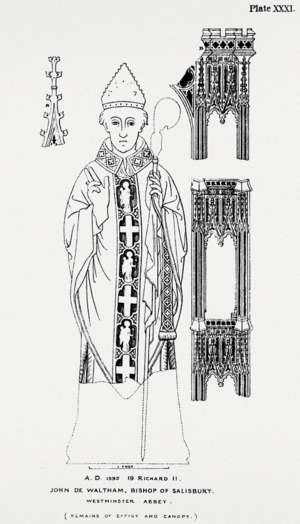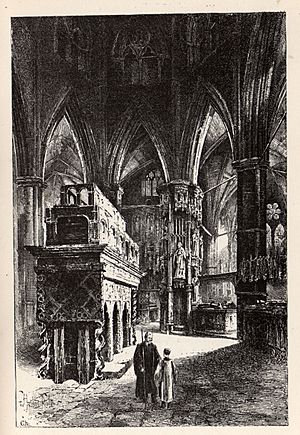John Waltham facts for kids
John Waltham was an important priest and government official in England. He lived in the 1300s. He worked for King Edward III and King Richard II.
John Waltham held many church and government jobs. He became the Lord High Treasurer and Lord Privy Seal of England. He also served as the Bishop of Salisbury. He is buried in Westminster Abbey in London.
Contents
John Waltham's Early Life

John Waltham was likely born in Waltham, Lincolnshire. Some people thought he was from Waltham in Essex. His parents were John and Margaret Waltham. Their memorial is still in All Saints' Church in Waltham.
John Waltham's great-uncle was John of Thoresby. He was a very important person. He served as Lord Chancellor of England. He was also the Archbishop of York.
Church and Government Jobs
As a priest, John Waltham held many important roles. He worked at the Cathedral Church of Southwell. He also held a position at Lichfield Cathedral. Later, he became a prebendary at York Minster.
In 1378, Waltham was a rector at St. Mary's Church in South Kelsey. He then worked at the church in Grendon, Northamptonshire. In 1379, he became a canon at St Andrew's Collegiate Church. He also served as rector of the Church of St Peter, Great Berkhamsted. From 1385 to 1388, he was the Archdeacon of Richmond.
Master of the Rolls and New Laws
From 1381 to 1386, Waltham was the Master of the Rolls. This job was in the Court of Chancery. This court dealt with fairness and justice. Waltham helped to make the court's power stronger.
He is known for creating the "writ of subpoena." This was a new court order. It made people come to court for a trial.
High Government Positions
In 1386, Waltham became the Lord Privy Seal. He held this job until 1389. He then served as Lord High Treasurer from 1391 until he died in 1395. This meant he managed the country's money.
In 1388, Waltham was one of the people who oversaw a big trial. This trial involved important figures like Alexander Neville, Archbishop of York.
Becoming Bishop of Salisbury
Pope Urban VI made Waltham the Bishop of Salisbury on April 3, 1388. He officially became bishop on September 20, 1388. King Richard II attended the ceremony.
As bishop, Waltham had a disagreement with the Archbishop of Canterbury, William Courtenay. Waltham refused to let Courtenay visit his area. He eventually gave in when Courtenay threatened to remove him from the church.
During this time, new ideas from John Wycliffe were spreading. Waltham worked to stop these ideas. He made the leaders of Salisbury agree to church rules. He also banned certain meetings.
Waltham had a home on Fleet Street in London. It was called Salisbury Court. In 1392, there was a riot there. After the riot, some London officials were put in prison. The king even replaced the Mayor of London.
Waltham was part of a group chosen in 1386. Their job was to improve the government. They also aimed to reduce the king's close friends' influence. Waltham became a close friend of King Richard II around 1390. The king showed his favor by making Waltham Lord Treasurer.
Death and Burial
John Waltham died on September 17, 1395. He had been bishop for seven years. King Richard II was very sad about his death.
Waltham wanted to be buried in Salisbury Cathedral. But King Richard II ordered him to be buried in Westminster Abbey in London. The king sent Sir William Scrope to bring Waltham's body to London.
Waltham was buried in the Chapel of Edward the Confessor. He is the only person not of royal blood buried there. This decision caused some debate. To calm things, King Richard gave the Abbey a lot of money. He also gave them two special robes called copes.
Waltham's grave is in the chapel's north-west corner. It is near the tombs of Edward the Confessor and Richard II. A special brass plate on the floor shows Waltham. It shows him in his church clothes. He wears a bishop's mitre and holds a crosier.



